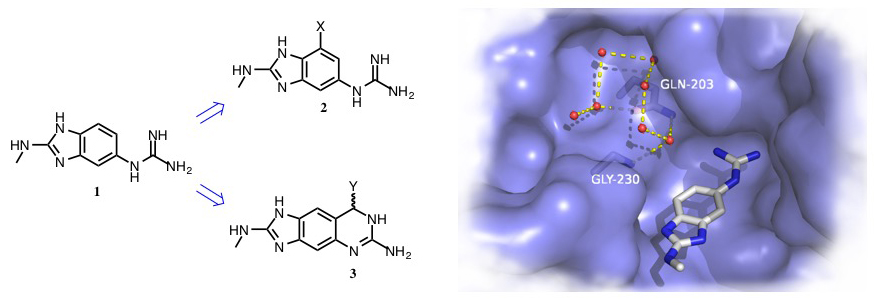Filling a Transient Subpocket of tRNA-guanine transglycosylase (TGT)
The bacterial enzyme tRNA-guanine transglycosylase (TGT) plays an important role in the control of virulence of Shigella flexneri and is a potential target in the treatment of shigellosis.1 The active site of bacterial TGT is highly conserved among species, and the enzyme is only active as homodimer, whereas in many eukaryotic species TGT is active as a heterodimer.2 Remarkably, with some benzimidazole-type ligands, tethered to a guanidinium moiety, a small subpocket in the active site of Z. mobilis TGT is opened.
An X-ray co-crystal structure of Z. mobilis TGT and ligand 1 revealed that the opened subpocket is hydrophilic and filled with water molecules, one of which solvates the Gly230 and Gln203 residues close to the entrance of the transient subpocket.
To exploit the newly opened chemical space for drug development, a series of ligands with vectors targeting this sub-pocket have been prepared (ligand series 2 and 3). This work presents the synthesis and initial results on the development of a new class of TGT inhibitors occupying the newly observed subpocket.

[1] (a) Simone R. Hörtner, Tina Ritschel,
Bernhard Stengl,
Christian Kramer,
W. Bernd Schweizer,
Björn Wagner,
Manfred Kansy,
Gerhard Klebe,
François Diederich, Angew. Chem. Int. Ed. 2007, 46, 8266-269. (b) Yi-Chen Chen, Allen F. Brooks, DeeAnne M. Goodenough-Lashua, Jeffrey D. Kittendorf, Hollis D. Showalter, George A. Garcia, Nucleic Acid Res. 2011, 39, 2834-2844.
[2] Inna Biela, Naomi Tidten-Luksch, Florian Immekus, Serghei Glinca, Tran Xuan Phong Nguyen, Hans-Dieter Derber, Andreas Heine, Gerhard Klebe, Klaus Reuter PLoS ONE 2013, 8, e64240